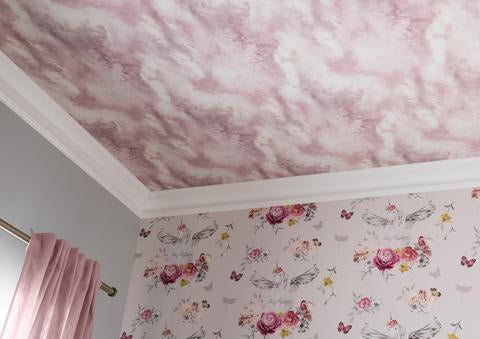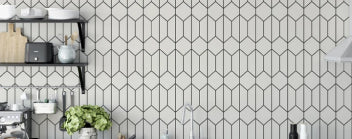The 5th Wall

Papering overhead may seem like a tricky process but it’s actually a lot easier than you might think. Depending on which wallpaper you choose, you can either paste the paper or paste the ceiling. We’ve put together a little how to guide to help you:
MEASURING IS KEY
- measure the dimension of your ceiling space with a tape measure;
- use our roll calculator to calculate how many rolls you’ll require;
- mark the ceiling with a straight line using a piece of string and two nails;
- measure 50cm out from the edge of the ceiling;
- using a pencil, mark across the string to create a straight line.
Next, you’ll need to make sure you have all the tools for the job and we’d recommend you have someone on hand to help you with the application.

YOU'LL NEED THE FOLLOWING TOOLS:
- Wallpaper brush (or a long-handled roller if you’re pasting the ceiling)
- Ladder
- Wallpaper paste – We recommend “ready mixed” paste
- Tape measure
- Scissors and sharp blade
- Spirit level, folding yardstick or a long piece of string
- Hanging brush
- Damp sponge
- Pasting table (if pasting the paper)
- Long-handled brush
As explained earlier, there are two types of wallpaper application:
PASTE THE PAPER
A more traditional method is to paste the paper on a trestle table.
- measure the length required (allow for a 5cm overlap on either side);
- unroll the wallpaper on your trestle table;
- apply the paste to the back of the paper;
- allow time for the paste to soak in.
PASTE THE CEILING
This application is faster than the traditional method and will save space as you won’t need a table.
- measure the length required (allow for a 5cm overlap on either side);
- apply the paste evenly onto the first section of the ceiling – too much paste will drip.
HANGING THE WALLPAPER
Now you can get going with the application. This is when you’ll need an extra pair of hands.
- Fold your paper 2/3 at one end and 1/3 at the other;
- Carefully climb the ladders, leaving at least 10cm between the ceiling and your head;
- Using the shorter end of the roll, hold it up against the edge of the ceiling and in line with the pencilled line you drew earlier;
- Once you’re sure the first piece is in the correct place spread out the paper slowly from the middle outwards as you go along. Pushing any bubbles out through the side of the paper;
- Unfold the remaining piece of roll and with a long-handled brush, your helper can hold up each section for ease;
- When you’ve placed your first piece on the ceiling, pushed all the bubbles away, score along the edge of the ceiling with a blade and use your scissors to cut the overlap away;
- Wipe paper with a damp sponge to remove any excess paste;
- Continue with your next piece of paper, aligning it against the previous roll.
BENEFITS OF PAPERING THE 5TH WALL
Wallpapering your ceiling can add more dimension to a room, it can also act as your feature wall if you want to keep the vertical walls bare or with a simpler design. Wallpapered ceilings can also play with your perceptions depending on the design of the print.
